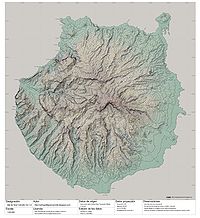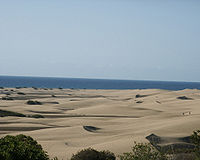Gran Canaria
 | |
| Geography | |
|---|---|
| Location | Atlantic Ocean |
| Coordinates | 27°58′N 15°36′W / 27.967°N 15.600°W |
| Archipelago | Canary Islands |
| Administration | |
Spain | |
| Demographics | |
| Population | 802,257 |
Gran Canaria is the third largest island of the Canary Islands, an archipelago located in the Atlantic Ocean 210 km from the northwest coast of Africa and belonging to Spain. It is located southeast of Tenerife and west of Fuerteventura. The island is of volcanic origin, mostly made of fissure vents.
The island was populated by the Canarios, who may have arrived as early as 500 BC. The Canarios called the island Tamarán. It was claimed by Spain in the 15th century.
Gran Canaria's surface is 1,560 km² and its maximum altitude is 1,949 meters (Pico de Las Nieves). It has a round shape, with a diameter of approximately 50 km.
It is divided into twenty-one municipalities:
The island has a population of 802,257 with 378,628 (year 2005) of those in the capital city of Las Palmas de Gran Canaria. Las Palmas de Gran Canaria is the biggest city of the Canary Islands, also the capital of the province of Las Palmas, and also one of the two capitals of the autonomous community of the Canary Islands, along with Santa Cruz de Tenerife.
History
The capital city of Las Palmas was founded on June 24, 1478, with the name "Real de Las Palmas" by Juan Rejón, head of the invading Castilian army. In 1492, Christopher Columbus anchored in the Port of Las Palmas (and spent some time on the island) on his first trip to the Americas.
Transportation


Gran Canaria has highways encircling the whole island and extending into the mountain areas. In the late 20th century, its superhighways, among the first in the Canary Islands, were opened and ran around Las Palmas, and were later extended to the north coast and the airport and subsequently to the south coast to account for increased tourist traffic. The superhighways are GC1, GC2, and GC31, and dual carriageways GC4 and GC5. The western and the northwestern parts, with the fewest tourists, are linked only with highways.
The International Airport of Gran Canaria-Gando is the only airport on Gran Canaria. It has so many aircraft and passengers passing through it each year that it is placed as one of the busiest in Spain. Gran Canaria also hosts the responsibility of controlling all air traffic of The Canaries.
The most important ports in Gran Canaria are The Port of La Luz, in the city of Las Palmas of Gran Canaria; Arguineguín's Port, which exports cement from a large factory; and Arinaga's Port, placed in the major industrial zone of Canaries and one of the major ones of Spain.
The ports which transport the most passengers are the Port of La Luz and the Port of Las Nieves, placed in the municipality of Agaete
Public transport on the island is provided by an extensive network of buses (Guaguas) and run by GLOBAL and Guaguas Municipales who operate a fleet of modern, air-conditioned buses. Drivers are helpful and the mix of tourists and 'locals' (especially in the resort areas) makes for an interesting ride, not to mention it being one of the best ways to actually see the island.
Plans for a Railway network linking the capital with the South have been approved by both the Gran Canaria Cabildo and the Canary Islands Government, though the discussion with the central Spanish Government hinges now on budget.
Tourism


This island is called a "Miniature Continent" due to the different climates and variety of landscapes found. The island is under protection as a Biosphere Reserve by UNESCO.
The number of annual visitors is 2.2 million (2,200,000). Most of the tourists visit the southern part of the island.
The north tends to be cooler while the south is warmer and sunny. The east coast of the island is flat dotted with beaches while the western coast is rockier and mountainous.
The island possseses 32[1] Natural Protected Spaces, that they emphasize the Rural Park of Nublo, Doramas's Jungle, the Ravine of Azuaje, Tamadaba, Pino Santo, etc.
Most tourists stay in the south of the island, which is sunnier and has less rain than the north. There is a large bird park, Palmitos Park, in the south of the island (currently closed to the public until further notice) as well as many beach resort communities. The resort communities start in the central eastern part of the southern coast in the Maspalomas area which includes the towns of San Agustín, Playa del Inglés, Sonnenland, and Maspalomas where most tourists visit. The Dunes of Maspalomas are located between Playa del Inglés and Maspalomas. Another tourist attraction is the lighthouse at Maspalomas situated at the western end of Maspalomas.
In Tarajalillo an Aeroclub exists from where tourist flights can be taken over the island.
Playa del Inglés is a popular destination for European gay tourists with bars, restaurants and businesses centered primarily in the Yumbo Centrum shopping center. A wonderful beach is found near the Maspalomas Dunes. Maspalomas is known throughout the world for its lighthouse, lagoon and magnificent beach.
Still further to the west along the southern shore, in the Municipality of Mogán, are the communities of Puerto Rico and Puerto de Mogán, a picturesque village referred to as "Little Venice" on account of its many canals.

Other attractions include Reptilandia Park, Cocodrilos Park, Roque Nublo (an 80m monolith), Cenobio de Valerón with about 290 caves, Cueva Pintada the most important archaeological park in Canary Islands and the botanical gardens Jardin Canario (in Tafira Alta) and Cactualdea (in La Aldea de San Nicolás). El Dedo de Dios, or "God's Finger" was a rocky spire jutting from the sea in Puerto de las Nieves, and was previously the signature attraction of the Canary Islands until it was destroyed by Tropical Storm Delta, that crossed the archipelago on November 2005 [1]. With its numerous off shore underwater attractions, scuba diving centres, guides and courses are readily available to take in the full beauty of the island.
Other famous rock formations are El Cura (also known as El Fraile), The Frog (La Rana), Bentayga, the Roque de Gando, and the Peñón Bermejo. The highest peak of the island is the Pico de las Nieves, with 1.950 m
The capital city of Las Palmas de Gran Canaria, in the north of the island, has a vibrant city life. Las Canteras Beach lies in the heart of the city. Las Palmas de Gran Canaria is also known for its annual Carnaval. It was the first stop of Christopher Columbus' expedition on his way back from the Americas, a commemoration of which is the Hermitage of San Antonio Abad, where the navigator prayed, and the Casa de Colón. Other attractions in the capital city include the Museo Canario (the most important archaeology museum in the archipelago), the Cathedral and the Plaza del Espíritu Santo.
The town of Agüimes, on the eastern part of the island, has been carefully restored, and its town centre, centered around its old church and a peaceful square, now evokes the quiet living of a traditional Canarian town. The district also has some of the best preserved cave dwellings, in the protected area of the Guayadeque Ravine, where even the church has been built into the hillside and visitors can find a number of popular cave restaurants. The district also includes the most renowned scuba diving area on the island: the marine reserve at the playa de El Cabrón just outside the town of Arinaga.
Other important towns are Telde and Vecindario (within the municipality of Santa Lucía de Tirajana) and Gáldar. In Arucas there is a magnificent Neogothic temple, popularly known as "Arucas' Cathedral", as well as a large fertile plain where bananas are grown. In Gáldar and its surroundings there is also a banana-growing plain and some remarkable archaeological remains, such as Cueva Pintada or Cenobio de Valerón's communal silos, ancient tombs, and the port of Sardina del Norte (one of the island's ports where, as in Las Palmas', Christopher Columbus used to get supplies for his ships). In Teror is kept the catholic image of Virgen del Pino, the patron saint of the Canary Islands.
Heading west along the southern coast is the fishing city of Arguineguín in the Municipality of Mogán. The market, which is held on Tuesdays, is the largest on the island.
See also
References
- ^ [http://www.gobcan.es/cmayot/espaciosnaturales/informacion/grancan_todo.html Espacios Naturales Protegidos de Gran Canaria Font: Gobierno de Canarias
External links
- Gran Canaria Official Website
- Template:Wikitravel
- Biosphere reserve of Gran Canaria
- Museum and archaeological park Cueva Pintada
- Webcam Gran Canaria
- Gran Canaria Info Guide to the Island in English and Spanish
- Pictures of Gran Canaria

